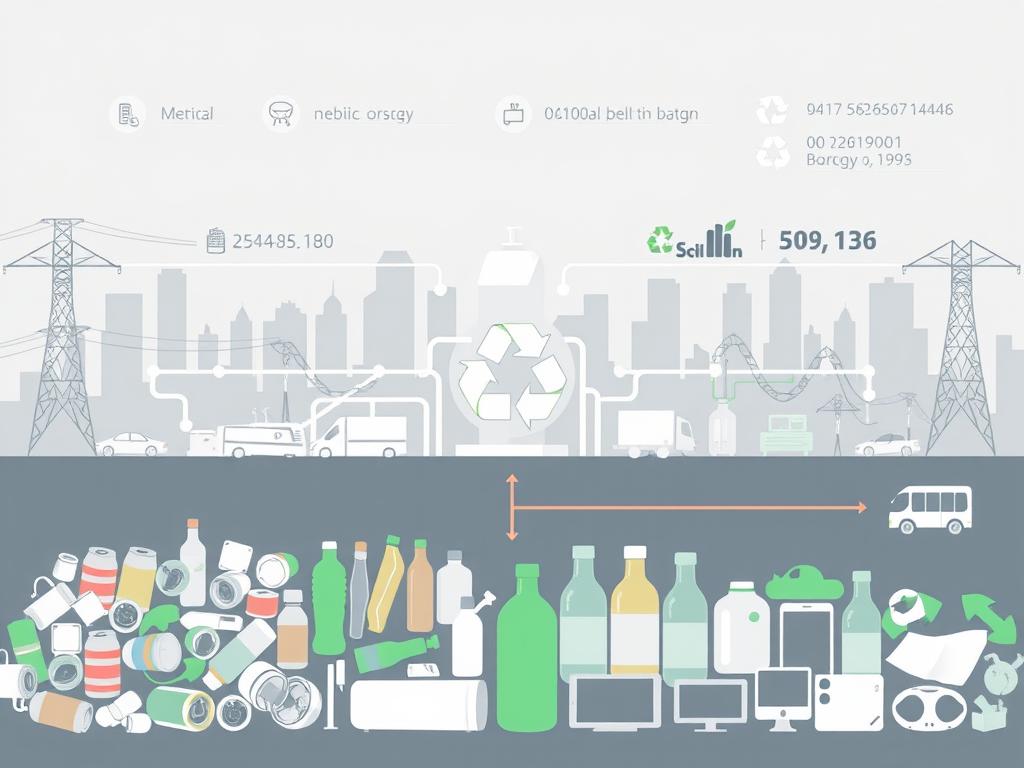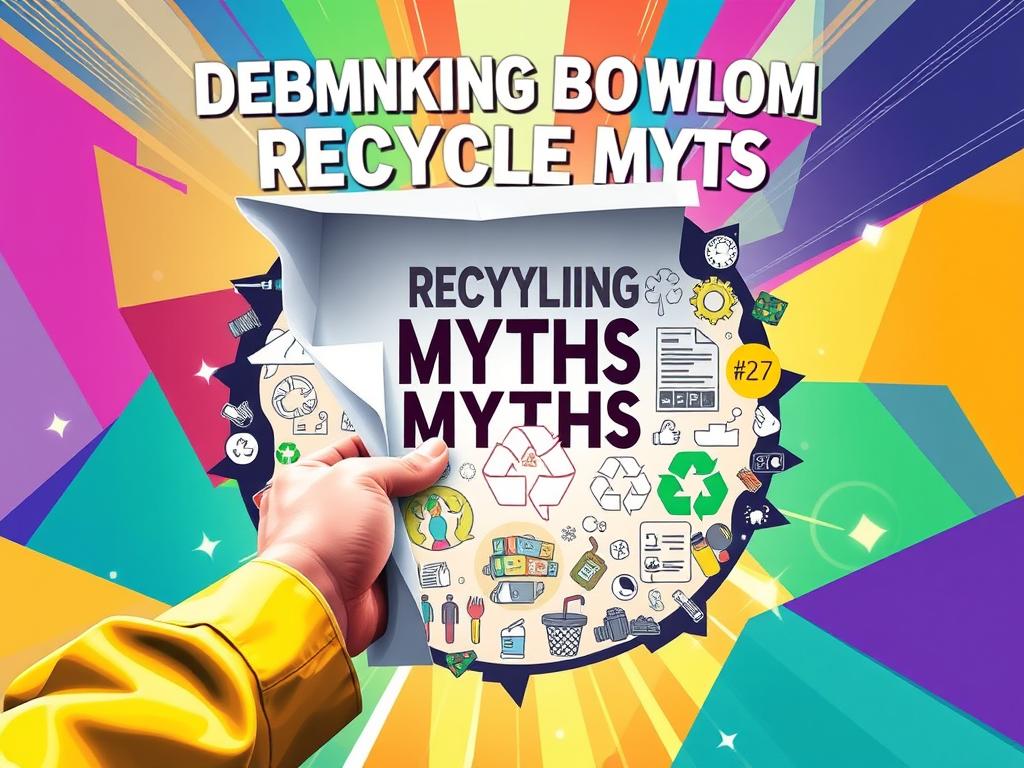Recycling is often seen as a key environmental solution in waste management. However, many myths challenge its true impact. The recycling industry, worth $265 billion in 2017, is set to grow significantly.
Sadly, about 55% of recyclable materials still end up in landfills. This shows a big gap between our intentions and actions. Recycling’s benefits are clear, though often misunderstood.
Recycling aluminium saves 95% of the energy needed for new materials. Paper recycling can save 17 trees per ton processed. These facts challenge doubts about recycling’s effectiveness in protecting our environment.
Let’s explore the complex world of recycling. We’ll look at its economic value and environmental challenges. We’ll also consider its potential for innovation.
By understanding waste management better, we can create more effective sustainable strategies. This knowledge will help us use our resources more wisely.
Understanding the Global Recycling Industry Today
The global recycling industry faces critical challenges and rapid changes. Recycling markets are shifting, requiring innovative approaches and strategic adaptations.
Current State of Recycling Markets
The U.S. generates over 260 million metric tons of waste yearly. The national recycling rate is low at 32%.
Only 21% of residential recyclables are successfully processed. About 40% of households lack consistent recycling services.
Impact of China’s Recycling Ban
China’s recycling ban disrupted global waste management practices. Countries now must develop local recycling infrastructure.
Residential recycling service costs have increased by 11%. This reflects the economic impact of the global policy change.
Economic Value of Recycling Industry
The recycling industry shows resilience despite challenges. Recycling rates have grown from 7% in 1960 to nearly 35% today.
Technological innovations drive investments in more efficient recycling processes. Environmental awareness also contributes to this growth.
The future of the global recycling industry depends on sustainable practices and innovative solutions.
Is Recycling a Waste of Resources?

Recycling plays a vital role in saving resources and energy. In 2017, the US recycled or composted 94.2 million tons of waste. This was out of a total 267.8 million tons of municipal solid waste.
Different materials have varying recycling efficiency rates. Aluminium cans top the list, saving 95% energy when recycled.
- Aluminum cans: 95% energy savings
- Steel and tin cans: 60-74% energy reduction
- Paper: 60% energy conservation
- Plastic and glass: Approximately 33% energy preservation
Recycling efficiency involves both economic and environmental factors. Single-stream recycling faces challenges, with about 25% of materials becoming contaminated. This reduces the overall effectiveness of recycling efforts.
| Material | Recycling Rate | Energy Savings |
|---|---|---|
| Aluminum | 50% | 95% |
| Paper | 66% | 60% |
| Plastics | 8% | 33% |
| Glass | 27% | 33% |
Despite challenges, recycling remains crucial for sustainable resource management. San Francisco showcases success with an 80% landfill diversion rate. This achievement stems from their well-planned recycling programmes.
The future of recycling depends on improving efficiency, reducing contamination, and developing innovative recycling technologies.
Common Misconceptions About Landfills and Decomposition
Waste management is more complex than many think. It challenges popular beliefs about landfill decomposition. Understanding waste breakdown reveals surprising insights into our environmental issues.
Landfills are not simple waste disposal sites. They’re complex environments where organic materials struggle to break down. The lack of oxygen creates environmental challenges, especially regarding methane emissions.
The Truth About Organic Waste in Landfills
Organic waste acts differently in landfills compared to natural settings. Key points include:
- Anaerobic decomposition prevents typical breakdown processes
- Oxygen-deprived environments dramatically slow waste degradation
- Organic materials emit substantial methane during decomposition
Environmental Impact of Methane Production
Methane emissions from landfills are a major environmental concern. They account for 34% of human-related methane emissions in the US. Methane traps 84 times more heat than carbon dioxide in the short term.
| Waste Type | Methane Emission Potential |
|---|---|
| Biodegradable Plastics | Highest Methane Release |
| Food Waste | Significant Methane Production |
| Yard Clippings | Moderate Methane Emissions |
Plastic Decomposition Reality
Plastic pollution is an alarming environmental challenge. Most plastics don’t decompose in the traditional sense. Instead, they break down into microplastics that persist in ecosystems for centuries.
This slow degradation greatly contributes to long-term environmental contamination. It highlights the need for responsible waste management and recycling strategies.
The Real Impact of Recycling Symbols and Labels
Recycling symbols often mislead consumers. These labels hide a complex reality about product recyclability. The plastic resin code, introduced in 1988, has caused widespread confusion among 68% of Americans.
The “chasing arrows” triangle doesn’t guarantee recyclability. These symbols mainly identify the type of plastic. Local recycling infrastructure varies greatly across regions.
- Resin codes (♳♴♵♶♷♸♹) only indicate plastic type
- Not all plastics with recycling symbols can be processed
- Local recycling infrastructure varies significantly
A Greenpeace USA survey revealed a stark truth. Plastics with resin codes #3–7 are nearly impossible to recycle. This is due to limited processing capabilities and market demand.
Only 9% of all plastics ever produced have been successfully recycled. This statistic highlights the urgent need for better recycling practices.
| Resin Code | Plastic Type | Recyclability |
|---|---|---|
| ♳ (PET) | Water bottles | Highly recyclable |
| ♴ (HDPE) | Milk jugs | Moderately recyclable |
| ♵-♹ | Various plastics | Low to no recyclability |
Consumers must critically assess product labelling. Greenwashing remains a significant issue in the industry. Companies often use eco-friendly labels that don’t reflect genuine recyclability.
The How2Recycle initiative aims to provide clearer guidance. However, only 3% of polypropylene containers are actually recycled. This shows the gap between labelling and reality.
“Recycling symbols are not a guarantee, but a starting point for understanding product sustainability.”
To make informed decisions, research your local recycling capabilities. Understand the limitations of recycling symbols. Proper waste management starts with knowledge and critical thinking about product labelling.
The Economics of Recycling: Myths vs. Reality
Recycling is more than just an environmental initiative. It’s a powerful economic engine driving job creation and resource value globally. The recycling industry generates significant economic opportunities while reducing waste and conserving resources.
The economics of recycling offer compelling insights into its growth potential. Global recyclables contribute billions to the world economy. Recycling facilities create thousands of green jobs.
Recycled materials often cost less than virgin resources. This makes them an attractive option for businesses looking to cut costs.
The recycling industry’s job creation potential is remarkable. Specialised facilities processing plastics, paper, and metals employ workers across multiple sectors. In 2021, it supported about 1.1 million jobs in the United States alone.
Resource value in recycling goes beyond immediate financial returns. By transforming waste into valuable materials, businesses can reduce production costs. They can also minimise their environmental footprint and generate new revenue streams.
The circular economy represents a transformative approach to sustainable economic development through strategic recycling practices.
Innovative technologies are making recycling more efficient and economically viable. Modern processes can transform materials like PET and HDPE into high-quality products. This demonstrates the true economic potential of effective waste management.
The Future of Recycling: Innovations and Challenges
Recycling is experiencing a remarkable transformation. Cutting-edge technology and waste reduction efforts are driving this change. Global plastic production might triple by 2060, highlighting the need for sustainable waste management.
The circular economy is reshaping our approach to recycling. Innovative solutions are emerging to tackle waste management challenges.
- AI-powered sorting systems improving recycling efficiency by up to 30%
- Chemical recycling techniques enabling plastics to be recycled up to 10 times
- 3D printing technologies reducing virgin plastic demand by 50%
- Blockchain tracking to enhance recycling supply chain transparency
The recycling industry faces significant hurdles. Only 9% of global plastic waste is recycled. In the United States, this figure drops to 5%. Technological advancements are critical to transforming these statistics.
The plastic recycling market shows promising growth. It’s expected to reach US$129.5 billion by 2031. This represents a 9.3% compound annual growth rate.
Regulatory changes are driving improvements in waste management. Extended Producer Responsibility schemes are being adopted in various regions. These include New Jersey, Oregon, and the European Union.
The future of recycling depends on collaboration. Manufacturers, waste managers, recyclers, and end-users must work together. This cooperation will create a sustainable recycling ecosystem.
A robust circular economy requires collective effort. It’s essential to support waste reduction and promote sustainable practices throughout the plastic value chain.
Conclusion: The True Worth of Recycling
Recycling remains crucial for environmental conservation, despite its complex economic landscape. Since 1970, recycling and composting have saved 4.5 billion barrels of oil. They’ve also reduced carbon emissions by over 5.5 billion tons.
Sustainable living requires a thoughtful approach to recycling. Challenges like increased costs and material contamination exist. However, recycling benefits are significant, especially for metals like aluminium.
Aluminium recycling uses 95% less energy compared to virgin production. Steel and paper recycling also offer substantial environmental advantages. These materials create far fewer greenhouse gas emissions than landfill alternatives.
Our choices as consumers are vital for effective recycling. Understanding material limitations helps us make better decisions. Plastics degrade after 2-3 processing cycles, while paper loses integrity after five.
The recycling industry creates 70 times more jobs than landfill and incineration. This highlights its economic and environmental importance. Improving recycling technologies and consumer education is crucial.
Success in recycling needs commitment from individuals, communities, and industries. Together, we can transform waste management into a truly sustainable practice.

